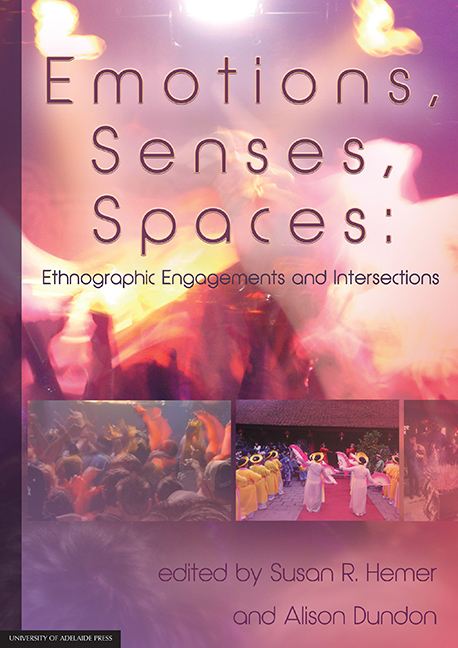Book contents
- Frontmatter
- Contents
- Biographies
- 1 Ethnographic intersections: Emotions, senses and spaces
- 2 ‘Dancing for joy’: Gender and relational spaces in Papua New Guinea
- 3 Creating the right ‘vibe’: Exploring the utilisation of space at Hip Hop concerts in Adelaide and Melbourne
- 4 Pontic dance: Feeling the absence of homeland
- 5 Emotional actors/Affective agents: Interspecies edgework and sociotechnical networks in the Spanish bullfight from horseback (rejoneo)
- 6 Sensual feasting: Transforming spaces and emotions in Lihir
- 7 Anxious spaces: The intersection of sexuality, the senses and emotion in fieldwork in Nepal
- 8 Interrupted research: Emotions, senses and social space in (and out of) the field
- 9 Voices in the park: The composition of sacred space and public place
- 10 Ngadha being-in-common: Emotional attachment to people and place in Flores, Indonesia
- 11 Trust your senses: Growing wine and making place in McLaren Vale
11 - Trust your senses: Growing wine and making place in McLaren Vale
Published online by Cambridge University Press: 25 July 2017
- Frontmatter
- Contents
- Biographies
- 1 Ethnographic intersections: Emotions, senses and spaces
- 2 ‘Dancing for joy’: Gender and relational spaces in Papua New Guinea
- 3 Creating the right ‘vibe’: Exploring the utilisation of space at Hip Hop concerts in Adelaide and Melbourne
- 4 Pontic dance: Feeling the absence of homeland
- 5 Emotional actors/Affective agents: Interspecies edgework and sociotechnical networks in the Spanish bullfight from horseback (rejoneo)
- 6 Sensual feasting: Transforming spaces and emotions in Lihir
- 7 Anxious spaces: The intersection of sexuality, the senses and emotion in fieldwork in Nepal
- 8 Interrupted research: Emotions, senses and social space in (and out of) the field
- 9 Voices in the park: The composition of sacred space and public place
- 10 Ngadha being-in-common: Emotional attachment to people and place in Flores, Indonesia
- 11 Trust your senses: Growing wine and making place in McLaren Vale
Summary
Abstract
This chapter argues that the tasks and processes of wine production undertaken by small‑scale producers not only serve to bring forth or unlock a ‘sense of place’ in the wine but can also be seen to continuously produce place itself. In the skilled performance of these tasks, winegrowers engage intimately with the world around them at a sensorial level: including touching the soil and the vines, feeling the sun, wind and rain in the vineyard, smelling and feeling the warmth of the fermenting grapes, and tasting the wine at different stages of its production. For many, such physical interaction (hands‑on doing) is extremely desirable in wine production, as wine's ‘authenticity’ is often considered to relate to the close interaction of people and place working in concert. It is this sort of deep and attentive sensorial engagement of people with their worlds, over time, that provides not only practical and intellectual ‘knowledge’ but also a rich topography of feelings and emotions attached to places and landscapes. I argue that the production of this sort of emotional space, via the hands‑on tasks and activities of small‑scale wine production, is a crucial element in the development among many such winegrowers of a relational or animic perspective, through which they see themselves, their vines, wines and other aspects of their worlds as fundamentally intertwined and interrelated. Wines, vines and wine places are thus invested with ‘meanings’ and ‘emotions’ — social products which are nevertheless linked inextricably to the sensuous materiality of production and consumption.
Introduction
Too many people sit in air conditioned cabins in their tractors, with a charcoal filter so they can't smell anything and a CD player so they can't hear anything, driving up and down the [vine] rows, and they're not connecting to the land … As a farmer, I think that you need to be really sensitive to the land: to feel the soil, touch the plants, take care and do things by hand. That's why we use basket presses as well. You could do it just as well with mechanised techniques but to actually do it by hand, to feel the grapes and work with them gently, you learn a lot more about what you're doing. (Peter, 17 April 2012)
- Type
- Chapter
- Information
- Emotions, Senses, SpacesEthnographic Engagements and Intersections, pp. 175 - 191Publisher: The University of Adelaide PressPrint publication year: 2016

